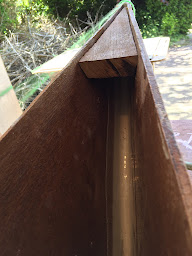Wooden Boat
An amateur boatbuilders blog
Kayak building.
Making Templates
The Stitch and Glue Method of boat building



Adding Internal Fillets
Removing the stitches
At this stage I need to remove the stitches from the filleted seams. To do this I use a heat gun and a pliers.
Clipping the copper just below the twist I apply the heat gun to the wire. This heats up the wire allowing it to become loose within the fillet. I then apply light pressure with the pliers and gently tug. In most cases the copper wire slides out without any problems.
Making the Breast and Bow Hook
The Deck.
Fibreglassing the Hull
Fibreglassing the Hull continued..
The next two coats will be the fill coat and the finish coat but before I do those I must build the boat's coaming.
Finish Fiberglass coating..
The Cockpit.
Now it is time for the cockpit to be built. At the point where the cockpit is attached the hull the structure to be built has to contend with several angle changes. The foredeck has a raised aspect and the aft deck is quite flat so in order to build a cockpit that might look well and perform well I had to build it in relation to the deck that already exists. To do this I covered the pilot position in a separating plastic film and built the cockpit up in layers. I did this with thin strips of mahogany. As I put each layer in place I glued it to the layer below and clamped the assembly to the deck, however the stretched plastic on the deck stopped the cockpit from bonding with the deck. This allowed the form to settle with the right angles while the glue cured.
The advantage of this is that I can fabricate a cockpit that fits exactly to the boat but remove it for cleaning and sanding before permanently attaching it to the hull.
A finished Kayak
At this point I now have a finished Kayak, bar painting and rigging.
Before beginning the final finish I seal the whole craft in another coat of epoxy.
This is done several times sealing and sanding each time. Each seal when cured is washed in a solution of warm water and vinegar to remove wax. The epoxy I am using will only cure in a vacuum so it has a wax component built into the resin, this wax is exuded when the temperature of the epoxy rises and it seals off the resin from the air blowing it to cure.
Finish Painting.
The end of the kayak build has arrived and it's time to finish coat the work and attach the rigging.
As this particular kayak has a nice wooden finish I have chosen to use paint on the hull and varnish on the deck. The whole kayak is already fibreglassed and has had several coats of epoxy. This fibreglass is now transparent. Epoxy can degrade in the presence of ultraviolet light so direct sunshine must be blocked out. In order to keep the deck finish looking I coat it in four layers of Epifanes spar varnish. This is a UV blocking medium and it looks well also. For the hull I have laid on a primer, and two undercoats. The final coat will be a marine paint.
Rigging.
The rigging for the kayak consists of bungie stretched across the deck and two hatches.
This arrangement I am creating is for personal taste, I am thinking more about having something to grab onto when I am upended out of the boat than anything else. The rigging consists of anchor points bolted through the hull to reinforced points. Stainless steel bolts of grade 316 are used throughout. I am also placing two storage hatches in the deck, one fore and one aft.





















